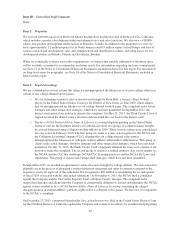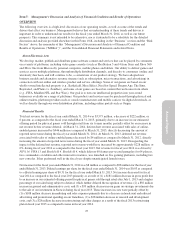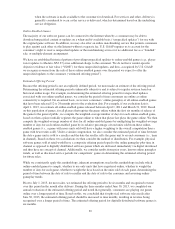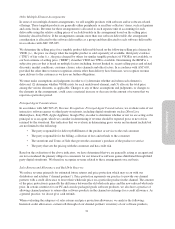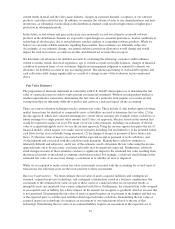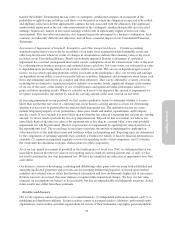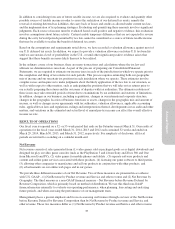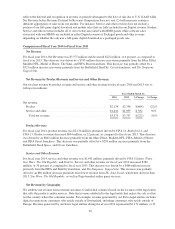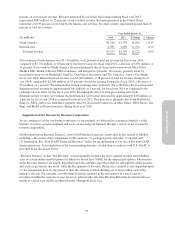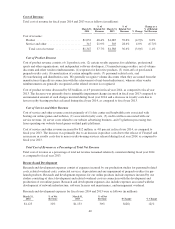Electronic Arts 2014 Annual Report Download - page 100
Download and view the complete annual report
Please find page 100 of the 2014 Electronic Arts annual report below. You can navigate through the pages in the report by either clicking on the pages listed below, or by using the keyword search tool below to find specific information within the annual report.when the software is made available to the customer for download. For services and other, delivery is
generally considered to occur as the service is delivered, which is determined based on the underlying
service obligation.
Online-Enabled Games
The majority of our software games can be connected to the Internet whereby a consumer may be able to
download unspecified content or updates on a when-and-if-available basis (“unspecified updates”) for use with
the original game software. In addition, we may also offer an online matchmaking service that permits consumers
to play against each other via the Internet without a separate fee. U.S. GAAP requires us to account for the
consumer’s right to receive unspecified updates or the matchmaking service for no additional fee as a “bundled”
sale, or multiple-element arrangement.
We have an established historical pattern of providing unspecified updates to online-enabled games (e.g., player
roster updates to Madden NFL 25) at no additional charge to the consumer. We do not have vendor-specific
objective evidence of fair value (“VSOE”) for these unspecified updates, and thus, as required by U.S. GAAP,
we recognize revenue from the sale of these online-enabled games over the period we expect to offer the
unspecified updates to the consumer (“estimated offering period”).
Estimated Offering Period
Because the offering period is not an explicitly defined period, we must make an estimate of the offering period.
Determining the estimated offering period is inherently subjective and is subject to regular revision based on
historical online usage. For example, in determining the estimated offering period for unspecified updates
associated with our online-enabled games, we consider the period of time consumers are online as online
connectivity is required. On an annual basis, we review consumers’ online gameplay of all online-enabled games
that have been released 12 to 24 months prior to the evaluation date. For example, if our evaluation date is
April 1, 2013, we evaluate all online-enabled games released between April 1, 2011 and March 31, 2012. Based
on this population of games, for all players that register the game online within the first six months of release of
the game to the general public, we compute the weighted-average number of days for each online-enabled game,
based on when a player initially registers the game online to when that player last plays the game online. We then
compute the weighted-average number of days for all online-enabled games by multiplying the weighted-average
number of days for each online-enabled game by its relative percentage of total units sold from these online-
enabled games (i.e., a game with more units sold will have a higher weighting to the overall computation than a
game with fewer units sold). Under a similar computation, we also consider the estimated period of time between
the date a game unit is sold to a reseller and the date the reseller sells the game unit to an end consumer (i.e., time
in channel). Based on these two calculations we then consider the method of distribution. For example,physical
software games sold at retail would have a composite offering period equal to the online gameplay plus time in
channel as opposed to digitally distributed software games which are delivered immediately via digital download
and thus have no concept of channel. Additionally, we consider results from prior years, known online gameplay
trends, as well as disclosed service periods for competitors’ games in determining the estimated offering period
for future sales.
While we consistently apply this methodology, inherent assumptions used in this methodology include which
online-enabled games to sample, whether to use only units that have registered online, whether to weight the
number of days for each game, whether to weight the days based on the units sold of each game, determining the
period of time between the date of sale to reseller and the date of sale to the consumer and assessing online
gameplay trends.
Prior to July 1, 2013, for most sales, we estimated the offering period to be six months and recognized revenue
over this period in the month after delivery. During the three months ended June 30, 2013, we completed our
annual evaluation of the estimated offering period and noted that generally, consumers are playing our games
online over a longer period of time. Based on this, we concluded that for physical software sales made after
June 30, 2013, the estimated offering period should be increased to nine months, resulting in revenue being
recognized over a longer period of time. The estimated offering period for digitally distributed software games is
six months.
30




